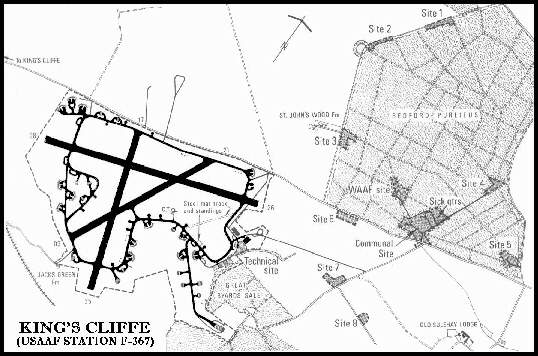ïŋ― ïŋ― ïŋ― Three days later, 485 (New Zealand) Squadron arrived with the inevitable Spitfire Vb. This squadron had the distinction of being New Zealand's first Fighter Squadron in England; becoming operational on April 12th., 1941.
ïŋ― ïŋ― ïŋ― The New Zealanders remained at King's Cliffe until October, 1942. Their place being taken by 93 Squadron, which has hardly settled in before being sent overseas to participate in Operation Torch, the invasion of North Africa.
ïŋ― ïŋ― ïŋ― King's Cliffe received it's first American Eighth Army Air Force Unit in December, 1942, when the 347th. Fighter Squadron arrived with Bell P-39 Airacobras. It's stay was short-lived, for by the following month, January, 1943, it had rejoined its parent Group and was replaced by the newly arrived 56th. Fighter Group.
ïŋ― ïŋ― ïŋ― The 56th. built up it's strength of Republic P-47C Thunderbolt fighters and practiced R.A.F. fighter control procedures. The Group then moved to Horsham St. Faith in April, 1943, to begin flying bomber escort missions.
ïŋ― ïŋ― ïŋ― Originally, King's Cliffe was grass surfaced, but paved runways an a perimeter track were laid by W.& C. French, Ltd., in early 1943. The longest runway being 1,700 yards in length along the east-west axis of the field. A number of blister hangers were constructed for covered maintenance; whilst a larger hanger, for protracted overhauls was erected in the southeast corner of the field.
ïŋ― ïŋ― ïŋ― With the departure of the 56th. Fighter Group, the field reverted to the R.A.F. and was used by two squadrons for a short period. These being 90 Squadron - May, 1943 and 349 (Belgian) Squadron, June-July, 1943.
ïŋ― ïŋ― ïŋ― The airfield became a front line Eighth Air Force base with the arrival of the 20th. Fighter Group in August, 1943 and was given the designation Station 367. As the field was too small to operate the Group's three-long-range Lockheed P-38 Lightning equipped squadrons, the 55th. Fighter Squadron was based at Wittering until May 26th., 1944 when it rejoined it's sister squadrons (77th and 79th. Fighter Squadrons) at King's Cliffe.
ïŋ― ïŋ― ïŋ― The 20th. commenced operations in December, 1943 and took part in all of the major daylight air battles of early 1944 and during the invasion period, June 1944, it's Lightnings, because of their distinctive shape, flew continuous cover over the invasion fleet.
ïŋ― ïŋ― ïŋ― Re-equipped with the North American P-51 Mustang in July, 1944, the 20th. flew a "Shuttle" mission to Russia in September and continued to fly bomber escort and ground strafing missions. By war's end in May, 1945, the Group had flown 312 combat missions from King's Cliffe. Accounting for 443 enemy aircraft destroyed as well as numerous ground targets, including 400 locomotives.
ïŋ― ïŋ― ïŋ― With the departure of the 20th. Fighter Group in October, 1945, King's Cliffe was once again in the hands of the R.A.F., who used the field to store armament until January, 1959. That same year, the site was sold and the runways torn up; the rubble being used in motorway construction. Today all that remains are a few revetments and a crumbling control tower.
(Reprinted from King's Cliffe Remembered - January, 1984)

Click to view larger version of map

For information concerning the area around King's Cliffe, click the button above.
THE KING'S CLIFFE MEMORIAL ïŋ― ïŋ―
RETURN TO THE 20TH.FG
RETURN TO CONTENTSïŋ― ïŋ―
RETURN TO THE NEWS/UPDATES
Unless otherwise noted, all content ïŋ― copyright The Art of Syd Edwards 1999. All rights reserved and reproduction is prohibited.
